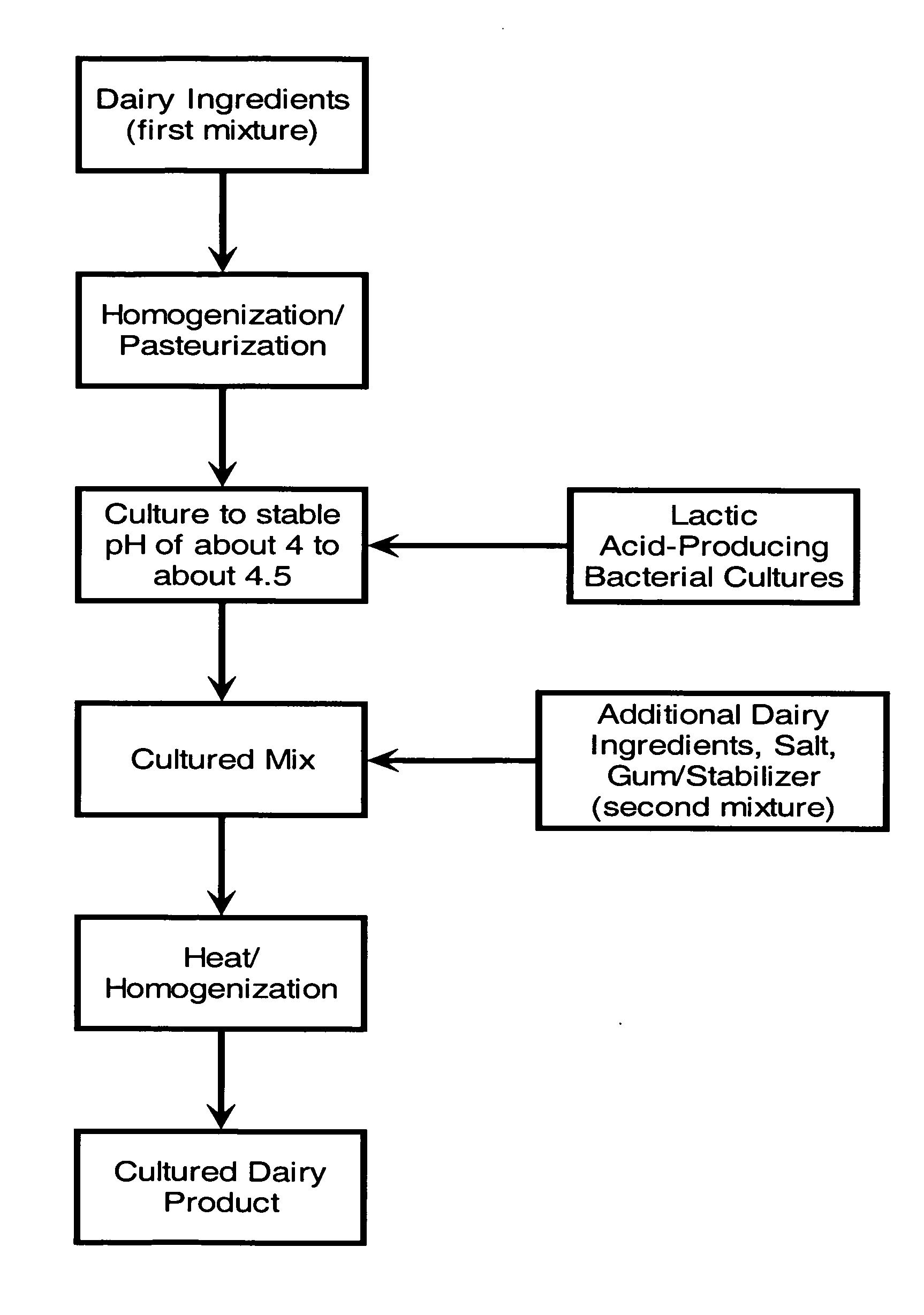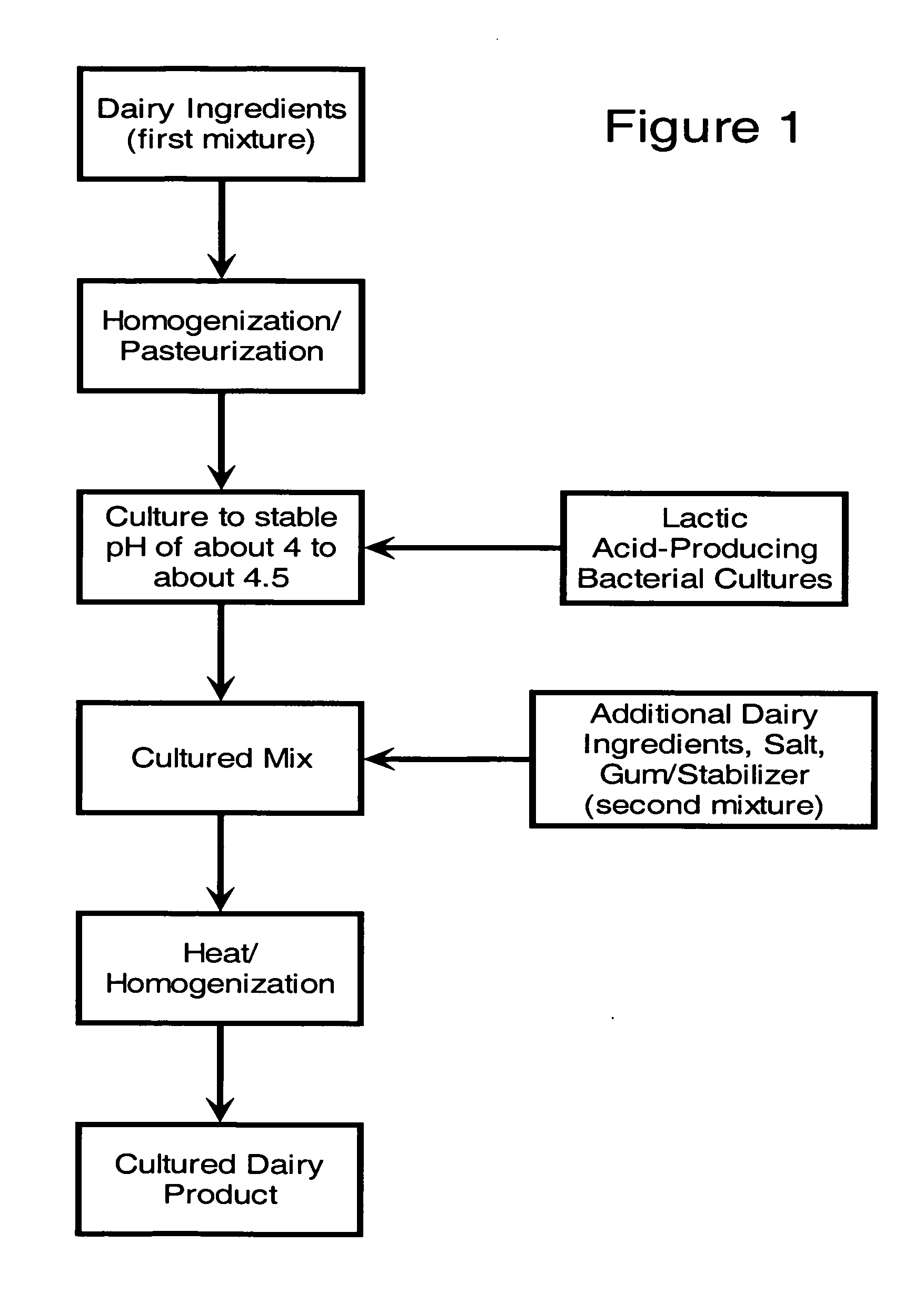Cultured dairy products and methods of manufacture
- Summary
- Abstract
- Description
- Claims
- Application Information
AI Technical Summary
Benefits of technology
Problems solved by technology
Method used
Image
Examples
example 1
[0033] An inventive full-fat cream cheese was prepared using the general method illustrated in the process flow diagram (FIG. 1). Pasteurized cream (39.6% butterfat) was cultured using about 1 percent of a lactic acid-producing bacterial culture (DSM Food Specialties, Milville, Utah) at about 72° F. to a steady-state pH of 4.43 (total time of about 12.5 hours). After heating to 180° F., ingredient additions were made as shown in the following recipe (based on 100 lbs finished product).
TABLE 1AIngredientAmount (lbs)Cultured Mix82.1Water8.2WPC (80% protein)5.1Whey Powder3.4Salt0.9Stabilizer / gum0.3TOTAL100.0
The whey protein concentrate (WPC) was from Glanbia Nutritional, Inc. (Monroe, Wis.); the whey powder was from American Milk Producers, Inc. (Jim Falls, Wis.; and the stabilizer / gum was locust bean gum from Danisco USA, Inc. (New Century, Kans.). After all ingredients were added, the blend was held for 10 minutes at 180 to 185° F. and subsequently homogenized at 3000 / 500 psi (fir...
example 2
[0036] An inventive reduced-fat cream cheese was prepared using the general method illustrated in the process flow diagram (FIG. 1). Milk and cream were blended, homogenized, and pasteurized to produce a dairy mix with the following composition:
TABLE 2AComponentAmount (%)Total Solids26.9Fat17.1Protein2.5Casein2.0Whey Protein0.5Lactose3.8
[0037] The dairy mix was cultured until the pH level reached steady state (pH 4.17). After heating from about 61 to about 180° F., ingredient additions were made as shown in the following recipe (based on 100 lbs finished product).
TABLE 2BIngredientAmount (lbs)Cultured Mix89.2WPC (80% protein)6.9Whey Powder2.5Salt0.9Stabilizer / gum0.5TOTAL100.0
The WPC and whey powder were the same as used in Example 1. The stabilizer / gum was a blend of about 80 percent locust bean gum (Danisco, USA, Inc., New Century, Kans.) and about 20 percent xanthan gum (CP Kelco, Chicago, Ill.). After all ingredients were added to the mix, the blend was held for 10 minutes a...
example 3
[0039] An inventive ultra-light cream cheese was prepared using the general method illustrated in the process flow diagram (FIG. 1). Milk and cream were blended, homogenized, and pasteurized to produce a dairy mix with the following composition:
TABLE 3AComponentAmount (%)Total Solids15.6Fat6.7Protein2.9Casein2.3Whey Protein0.6Lactose4.7
[0040] The dairy mix was cultured to a steady-state pH of 4.17. After heating from about 58 to about 180° F., ingredient additions were made as shown in the following recipe (based on 100 lbs finished product).
TABLE 3BIngredientAmount (lbs)Cultured Mix85.4WPC (80% protein)11.9Whey Powder1.3Salt0.9Stabilizer / gum0.5TOTAL100.0
[0041] The WPC, whey powder, and stabilizer / gum blend were the same as used in Example 2. After all ingredients were added to the mix, the blend was held for 10 minutes at about 180 to about 185° F. and subsequently homogenized at 3000 / 500 psi (first and second stage). Product was collected out and packaged. The inventive cream ...
PUM
 Login to View More
Login to View More Abstract
Description
Claims
Application Information
 Login to View More
Login to View More - R&D
- Intellectual Property
- Life Sciences
- Materials
- Tech Scout
- Unparalleled Data Quality
- Higher Quality Content
- 60% Fewer Hallucinations
Browse by: Latest US Patents, China's latest patents, Technical Efficacy Thesaurus, Application Domain, Technology Topic, Popular Technical Reports.
© 2025 PatSnap. All rights reserved.Legal|Privacy policy|Modern Slavery Act Transparency Statement|Sitemap|About US| Contact US: help@patsnap.com


